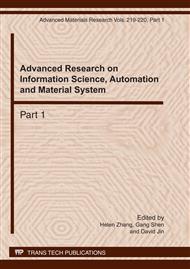[1]
Zhao X Y, Li H N. A improved denoising mathod based on wavelet analysis and its application in structure health monitoring [J]. Journal of vibration and shock, 2007, 26(10):137-139. (In Chinese).
Google Scholar
[2]
Xia W J, FU X J. De-noising in Intensive Noises Vibration Signal Based on Independent Component Analysis (ICA) [J]. Turbine technology, 2006, 48(2):121-123. (In Chinese).
Google Scholar
[3]
Jiao W D, Yang S X, Wu Z T. Study of Noise Removal Technique Based on Independent Component Analysis [J]. Journal of Zhejiang University (Engineering Science), 2004, 38(7):872-876. (In Chinese).
Google Scholar
[4]
Hyvärinen A, Karhunen J, Oja E. Independent Component Analysis [M]. John Wiley, New York, (2001).
Google Scholar
[5]
Cichocki A, Amari S. Adaptive Blind Signal and Image Processing [M]. John Wiley, New York, (2003).
Google Scholar
[6]
Hyvärinen A, Ramkumar P, Parkkonen L, Hari R. Independent component analysis of short-time Fourier transforms for spontaneous EEG/MEG analysis [J]. NeuroImage, 2010, 49(1):257-271.
DOI: 10.1016/j.neuroimage.2009.08.028
Google Scholar
[7]
ZuoMing J, Lin Jing, Fan Xianfeng. Feature separation using ICA for a one-dimensional time series and its application in fault detection [J]. Journal of Sound and Vibration, 2005, 287(3):614-624.
DOI: 10.1016/j.jsv.2005.02.005
Google Scholar
[8]
Choi Seungjin, Cichocki Andrzej, Park Hyung-Min, Lee Soo-Young. Blind Source Separation and Independent Component Analysis: A Review [J]. Neural Information Processing, 2005, 6(1):1-57.
Google Scholar
[9]
Tse Peter W, Zhang J Y, Wang X J. Blind source separation and blind equalization algorithms for mechanical signal separation and identification [J]. Journal of Vibration and Control, 2006, 12(4):395-423.
DOI: 10.1177/1077546306063248
Google Scholar
[10]
Yang Y, Yuan H Q, Zhao L Z. Application of Independent Component Analysis in Noise Reduction of Structural Vibration Signal [J]. Journal of Huazhong Univesity of Science and Technolony (Urban Science Edition), 2008, 25(3):234-237. (In Chinese).
Google Scholar
[11]
Hyvärinen A. Fast and robust fixed-point algorithms for independent component analysis [J]. IEEE Trans.Neural Networks, 1999, 10(3):626-634.
DOI: 10.1109/72.761722
Google Scholar
[400]
800](a).
Google Scholar
[1200]
1600][2000]-40 -20.
Google Scholar
[400]
800](b).
Google Scholar
20][40](ms) (mv) Observed Signal.
Google Scholar
[400]
800][1200][1600][2000]-10 -5.
Google Scholar
[400]
800][1200][1600][2000]-20 -10.
Google Scholar
10][20](ms) (mv) (a) (b) Separated Signal Fig.3 Observed signal of impulse and sin-wave Fig.4 Separated signal of impulse and sin-wave.
Google Scholar
[400]
800][1200][1600][2000]-40 -20.
Google Scholar
20][40](ms) (mv) Observed Signal (b) (a).
Google Scholar
5][10](ms) (mv) Separated Signal (a) (b) Fig.5 Observed signal of impulse and random Fig.6 Separated signal of impulse and random.
Google Scholar


